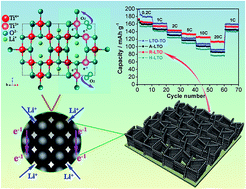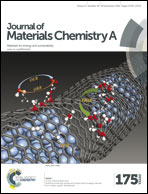Black mesoporous Li4Ti5O12−δ nanowall arrays with improved rate performance as advanced 3D anodes for microbatteries†
Abstract
Binder-free and self-standing lithium titanate nanoarrays could be promising 3D anodes for lithium-ion microbatteries. The intrinsic poor electrical conductivity of Li4Ti5O12, however, spoils its rate performance and restrains its application in commercial batteries. In this work, black mesoporous Li4Ti5O12−δ nanowall arrays with oxygen vacancies are synthesized by a facile hydrothermal method with post heat treatment in an Ar atmosphere. The heat treatment in an inert atmosphere is effective for generating oxygen vacancies by forming Ti3+ ions in Li4Ti5O12−δ nanowall arrays, thus greatly enhancing the electron transfer in the spinel structure. Consequently, the black mesoporous Li4Ti5O12−δ nanowall arrays exhibit greatly improved electrode kinetics and rate performance compared to the stoichiometrical Li4Ti5O12 and Li4Ti5O12/TiO2 dual phase nanowall arrays. In specific, the black mesoporous Li4Ti5O12−δ nanowall arrays can deliver a large specific capacity of about 115 mA h g−1 at 20C as well as excellent cycling stability, making them promising as 3D anodes for advanced lithium-ion microbatteries.


 Please wait while we load your content...
Please wait while we load your content...